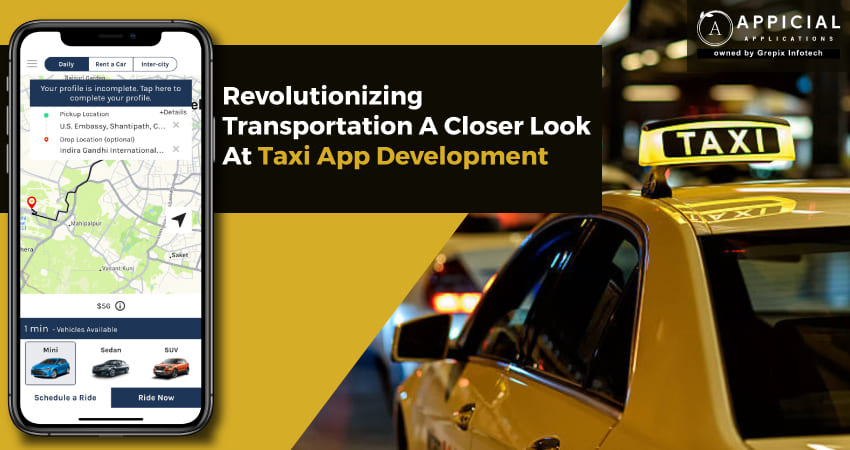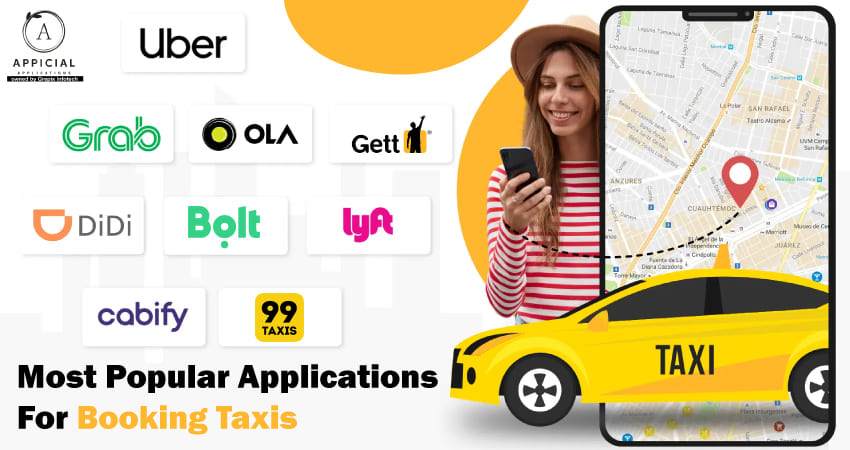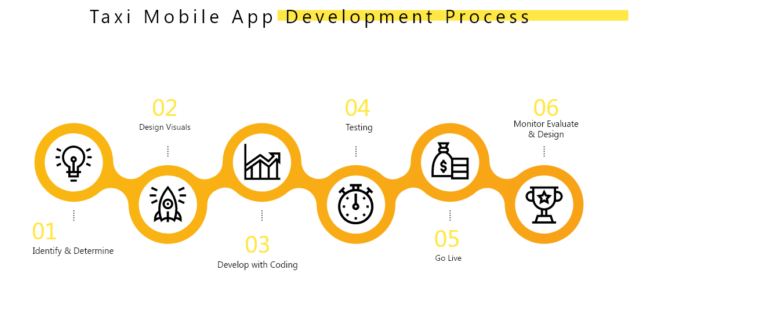
Revolutionizing Transportation: A Closer Look At Taxi App Development
In the fast-paced realm of urban mobility, the evolution of transportation has been nothing short of revolutionary. Among the myriad transformations, the advent of taxi app development stands out as a game-changer, reshaping the way we commute and experience the world around us.
In this blog, we embark on a comprehensive exploration of the dynamic landscape of taxi app development, uncovering the technological marvels that power these platforms and the profound impact they've had on the traditional taxi industry. From the genesis of the idea to the intricacies of the app architecture, we'll delve into the nuts and bolts of crafting an efficient and user-friendly taxi app.
As we traverse this digital terrain, we'll unravel the story of how taxi apps have not only simplified our daily commute but have also catalyzed significant shifts in consumer behavior, urban planning, and business models. We'll examine the challenges faced by developers, the innovations driving this sector forward, and the ever-evolving trends that are shaping the future of taxi app development.
Take a closer look at the intricate process of taxi app development, from conceptualization to implementation. This blog post provides a comprehensive overview of the key stages involved in creating a successful taxi app. Whether you're a developer, entrepreneur, or tech enthusiast, gain valuable insights into the challenges, considerations, and best practices that drive the development of cutting-edge taxi apps.
Taxi Industry Statistics
The global taxi market is expected to grow from its 2019 valuation of $69.18 billion to $120.89 billion by 2027, with a compound annual growth rate (CAGR) of 12.3%. Health and safety concerns make users prefer to drive their cars, which will limit the market size in 2020.
Market forecasts indicate that the global market for online taxi services will expand from $23.42 billion in 2020 to $28.65 billion in 2021 at a compound annual growth rate (CAGR) of 22.3%. By 2026, it is predicted to reach USD 327.54 billion, a growth rate of 8.95 percent per year during the period of the projected year (2021–2026).
As of my last knowledge update in January 2022, several well-known taxi booking applications have made a significant impact on the transportation industry. Please note that the popularity and availability of these apps can vary by region, and there might be new developments or emerging players in the market since my last update. Here are some of the most well-known taxi booking applications:

The Evolution of Ride-Hailing Apps
The traditional taxi industry faced numerous challenges, including inconsistent pricing, lack of transparency, and limited accessibility. The emergence of Ride-Hailing Apps addressed these issues by offering:
- Real-time tracking: Passengers could now monitor their driver’s location on a live map, providing greater assurance, safety, and predictability. This eliminated the uncertainty of not knowing when—or if—a taxi would arrive.
- Transparent pricing: Unlike traditional taxis, where fares could vary unpredictably, ride-hailing apps provided upfront fare estimates based on distance, traffic, and demand. This level of clarity built user trust and set new industry standards.
- Convenient payments: Integrated digital payment systems allowed riders to pay through credit/debit cards, mobile wallets, or in-app balances, eliminating the hassle of cash transactions and providing seamless, contactless experiences.
Companies like Uber and Lyft pioneered this model, setting the stage for others to develop their versions, often referred to as Uber Clone Apps.
Most Popular Taxi Booking Applications
The world of transportation has been revolutionized by the emergence of various well-known taxi booking applications that have become integral to our daily lives. Uber, a global giant, stands as a household name, providing seamless rides in countless cities. Lyft, Uber's prominent competitor, dominates the North American market with its user-friendly interface and diverse ride options. Didi Chuxing has transformed the way people travel in China, offering an array of services beyond taxi hailing. Ola, a key player in India, has carved its niche with varied ride choices, while Grab has become synonymous with ride-hailing in Southeast Asia. These applications, along with others like Gett, Cabify, Gojek, Bolt, and 99, have not only redefined urban mobility but have also expanded their services to include food delivery, financial transactions, and more, creating a comprehensive ecosystem that continues to shape the future of transportation.
Uber
Uber is also known for its early adoption of technology such as dynamic pricing and autonomous vehicle research, setting industry standards. It offers various services, including UberX (standard rides),UberPOOL (shared rides), and UberEats (food delivery).
Lyft
Operating primarily in the United States and Canada, Lyft is a major competitor to Uber. Lyft provides a range of ride options, including standard rides, shared rides, luxury rides, and scooter rentals.Lyft emphasizes community engagement and has a strong reputation for driver-friendly policies and sustainability initiatives.
Didi Chuxing
Didi is a major ride-hailing platform in China. It offers a wide range of transportation services, including taxi hailing, private car hailing, and more. Didi has also expanded its services internationally.
Ola
Based in India, Ola is one of the largest ride-hailing companies in the country. It provides various services, including Ola Micro, Mini, Prime, and Ola Auto, catering to different user needs.Ola has also diversified into electric vehicles and financial services, which makes it a significant player in India’s tech ecosystem.
Grab
Operating in Southeast Asia, Grab is a ride-hailing platform that offers services such as GrabCar, GrabTaxi, and GrabBike. It has expanded its services to include food delivery and financial services.Grab has evolved into a super app, which offers everything from ride-hailing to digital payments and insurance products.
Gett
Originally launched in Israel, Gett operates in several countries, including the United Kingdom, Russia, and the United States. It focuses on providing black car services and taxi-hailing.
Cabify
Operating in multiple countries across Europe and Latin America, Cabify offers private car services and taxi-hailing. It aims to provide a premium experience with professional drivers.Cabify emphasizes safety, sustainability, and fair working conditions, positioning itself as a socially responsible alternative.
Bolt (formerly Taxify)
Bolt operates in various countries, primarily in Europe and Africa. It provides ride-hailing services with a focus on affordability and driver satisfaction.
99 (formerly 99Taxis)
Operating in Brazil, 99 is a popular ride-hailing service that offers various transportation options, including taxis and private car services.
General Features Of A Taxi Booking App
Passengers App
- Social Login/Registration
- Create Profile
- Fare Summary and Details
- Real-time vehicle tracking
- Multiple payment methods
- SOS Button
- Ride now or later.
- Reviews and ratings
- Auto-generated bill
- Vehicle Categories
- View ride history
Driver App
- Edit/Update Profile
- Accept or reject booking requests
- Call/Chat
- Driver’s Multiple Shifts
- Earnings Report
- Driver’s Availability
- Geo-fenced Service Area
- Google Navigation
- Ride History
Admin Panel
- Users Manager
- Trips/Rides Manager
- Reports for revenue and transactions
- Transaction Manager
- Wallet Manager
- Driver Manager
Essential Features Of The Taxi Booking App
A well-designed taxi booking app typically incorporates a range of features to enhance the user experience, ensure safety, and streamline the overall transportation process. Here are key features commonly found in taxi booking applications:
1 User Registration
- User accounts with personal details and preferences.
- Secure login options include email and social media.
2 Real-Time GPS Tracking
- GPS integration for real-time tracking of the user's location.
- Driver tracking for users to monitor the approaching vehicle.
3 Fare Estimation
- Transparent fare calculation based on distance, time, and additional factors.
- Upfront fare estimates inform users of the expected cost.
4 Multiple Ride Options
- Different ride categories (e.g., standard, premium, shared) cater to various preferences and budgets.
5 In-App Payments
- Secure and seamless payment options, including credit and debit cards, digital wallets, and mobile payment solutions.
- Digital receipts for transparency and record-keeping.
6 Rating and Review System
- Two-way rating and review system for both passengers and drivers.
- Feedback mechanism to maintain service quality and accountability.
7 Ride History
- Record past rides, including details such as date, time, and fare.
- Rebooking options for frequently visited locations.
8 Push Notifications
- Instant alerts for ride confirmation, driver arrival, and other important updates.
- Promotional notifications and discounts.
9 SOS Button
- Emergency SOS button for immediate assistance.
- Share trip details with contacts for added security.
- Driver verification and background checks.
10 Driver App
- Dedicated app for drivers with features like ride acceptance, navigation, and earnings tracking.
- Profile management for drivers, including license verification.
11 Promo Code
- Integration of promotional codes for discounts and special offers.
- Loyalty programs to reward frequent users.
12 Multi-Language Suppor
- Language options to cater to a diverse user base.
13 Rides Now or Later
- Pre-scheduling rides for a later time or date
14 User-friendly Interface
- User-friendly design with clear navigation and a minimalistic layout.
- Smooth onboarding process for new users.
Also Read: WHY SHOULD TAXI BUSINESSES INVEST IN BRANDED TAXI APP DEVELOPMENT?
Benefits Of Developing A Taxi Booking App
Developing a Taxi Booking Application through professional mobile app development offers numerous benefits for both entrepreneurs and users. Here are some key advantages of developing a taxi booking app:
- Enhanced Convenience Users can book a ride with just a few taps on their smartphones, eliminating the need to hail a cab on the street or wait at a taxi stand. A seamless Ride-Hailing App experience boosts user satisfaction and adoption.
- Time and Cost Efficiency Efficient routing algorithms in a well-built Taxi Dispatch Software optimize travel routes, minimizing travel time and reducing overall transportation costs for both passengers and drivers.
- Cashless Transactions In-app payment options facilitate cashless transactions, providing a secure and convenient payment experience. This is a standard feature in any competitive Uber Clone App.
- User Reviews and Ratings The built-in review and rating system enhances trust and accountability, allowing users to make informed decisions. This transparency is a key factor in the success of any Ride-Hailing App.
- Increased Safety Measures Modern Taxi Booking Applications include safety features like emergency SOS, driver background checks, and trip-sharing, ensuring a secure On-Demand Transportation experience.
- Flexible Business Models Taxi App Development supports various models—ride-sharing, premium rides, or hybrid models—giving business owners flexibility to monetize according to market demands.
- Revenue Opportunities Features such as in-app advertising, surge pricing, and partnerships enable multiple revenue streams. A smart Uber Clone App can be a powerful business tool beyond basic transport.
- Global Accessibility With proper localization and scalability, Taxi Booking Applications can operate globally, allowing users to access reliable Urban Mobility Solutions across different countries and cities.
- Customer Loyalty Programmes Integrating loyalty rewards and promotional campaigns into your Taxi Booking App can help retain users and drive frequent engagement.
- Environmental Impact By promoting ride-sharing and route optimization, Taxi Dispatch Software can help reduce traffic congestion and carbon emissions, making it a more sustainable Urban Mobility Solution.
- Technological Innovation Building a Taxi Booking App enables businesses to adopt cutting-edge tech like AI-driven dispatch, IoT integration, and predictive analytics to gain a competitive edge in the Mobile App Development landscape.
- Brand Visibility and Recognition A well-designed and functional Taxi Booking Application significantly boosts brand visibility, positioning your service as a reliable player in the Ride-Hailing App market.
How To Create A Successful Taxi Booking App
Creating a taxi booking app involves several steps, from conceptualization to development and deployment. Below is a comprehensive guide to help you navigate the process:
1 Define Your Objectives
Before diving into development, clearly define the objectives of your taxi booking app. Identify your target audience, unique selling points, and the geographic locations you plan to cover.Consider how your app will contribute to urban mobility solutions and stand out from competitors like an Uber Clone App.
2 Market Research
Conduct thorough market research to understand your competitors in the ride-hailing app ecosystem, identify gaps in the market, and gather insights into user preferences. This information will help you tailor your Taxi Booking Application to meet user needs effectively and position your app for success in the urban mobility solutions space.
3 Choose A Business Model
Decide on the business model for your Taxi App Development. You can opt for a commission-based model where drivers pay a percentage of their earnings, a subscription model, or a hybrid model combining various revenue streams. Many successful Uber Clone Apps leverage this flexibility to maximize profitability.
4 Plan The Features
Planning the features of a taxi booking app is a crucial step in ensuring a seamless and user-friendly experience for both passengers and drivers. The app's functionality should address the core needs of users, encompassing features such as user registration and profiles for personalized experiences, real-time geolocation for accurate tracking, a user-friendly booking interface, and transparent fare estimation. Additionally, integrating secure payment gateways, a robust driver matching algorithm, timely notifications, and a feedback system through ratings and reviews contribute to the overall efficiency and reliability of the application. A well-designed admin dashboard complements these features, allowing for effective management and maintenance of the platform.
5 Design the user interface (UI) and user experience (UX)
Create a visually appealing and user-friendly design for your Taxi Booking Application. Focus on simplicity and intuitive navigation. Consider hiring a professional UI/UX designer to ensure your mobile app development results in an optimal user experience that aligns with expectations in modern on-demand transportation platforms.
Conduct extensive testing to identify and fix bugs, ensuring a smooth and reliable user experience. Perform testing on different devices and operating systems to guarantee compatibility.
6 Deploy The App
Once testing is complete, deploy your Taxi Booking Application on app stores such as the Apple App Store and Google Play Store. Ensure all necessary metadata, screenshots, and descriptions are optimized for visibility. Use keywords related to urban mobility solutions, on-demand transportation, and ride-hailing app to improve app discoverability.
7 Implement Marketing Strategies
Develop a marketing plan to promote your Taxi Booking Application. Utilize digital marketing channels, social media, and strategic partnerships to increase visibility and attract users. Promote unique selling points such as your innovative use of Taxi Dispatch Software or features that rival top Uber Clone Apps.
8Monitor And Update
Regularly monitor user feedback, app performance, and market trends. Implement updates and improvements based on user reviews and technological advancements in mobile app development. Continuous innovation ensures your ride-hailing app remains competitive in the dynamic urban mobility solutions ecosystem.
Taxi Booking App Development Process
Developing a taxi booking app involves a series of steps, from planning and design to implementation and launch. The cost of your taxi booking app will also depend on the procedure you use. Let's examine the steps a mobile app development company takes to create a taxi booking app.

Why Appicial's Taxi App Is Better Than Competitors
1 Direct Access To The Technical Team
You have direct access to our experienced technical experts whenever and wherever you need them. This ensures a convenient and timely response to your questions during the Taxi Booking Application lifecycle, supporting seamless communication throughout the mobile app development journey.
2Future Changes And Updates
We provide ongoing updates for your Taxi Booking App, ensuring compatibility with the latest OS versions. Our continuous improvement approach supports long-term success in the evolving ride-hailing app market.
3Free Technical Support
When you purchase a Taxi App Development solution from Appicial, you receive free technical support. Our team is ready to assist you post-deployment, helping maintain the smooth operation of your on-demand transportation system.
499% Of Working Products Live In The Market
Our Uber Clone App is pre-built, thoroughly tested, and already live on app stores. With a 99% success rate, our products are well-received in the urban mobility solutions space, making them a reliable choice for startups and enterprises alike.
5Robust Testing With 1000s Of Live Drivers
Our Taxi Dispatch Software has undergone extensive testing with thousands of active drivers to ensure stability, reliability, and real-world usability. This ensures that your ride-hailing app delivers a seamless experience from day one.
Conclusion
Appicial Applications is a leading mobile app development firm, recognized by Clutch, GoodFirms, and AppFutura. With over 11 years of experience, we’ve delivered robust Taxi App Development solutions to startups and established brands across the globe. Whether you need a custom-built platform or a scalable Uber Clone App, we have the expertise to transform your vision into a profitable business.
After reading this blog post, we hope all of your questions about Taxi Booking Application development have been answered. To learn more about our Taxi Dispatch Software or get started on your ride-hailing app, feel free to get in touch with our team.
Looking out to start your own venture like Uber? Try out our HireMe Taxi Uber Clone, the easiest way to kick-start your taxi business.





